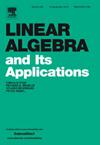没有指定长度路径的图的最大扩展
IF 1.1
3区 数学
Q1 MATHEMATICS
引用次数: 0
摘要
图的扩展被定义为其邻接矩阵的最大和最小特征值之差。在本文中,我们研究了禁止给定长度路径的图的扩展的极值问题。当k≥1且n足够大时,我们证明了实现最大扩展的n顶点P2k+2自由图是k顶点团和n−k顶点的独立集合的连接。我们还证明了P2k+3-free图的极值图:•对于k∈{1,2},扩展是通过k顶点团与n−k−2个顶点的独立集的边的不相交并的连接而最大化的。•对于k≥3,扩展通过k顶点团与n−k顶点的独立集合的连接而最大化。本文章由计算机程序翻译,如有差异,请以英文原文为准。
Maximum spread of graphs without paths of specified length
The spread of a graph is defined as the difference between the largest and smallest eigenvalues of its adjacency matrix. In this paper, we investigate extremal problems for the spread of graphs that forbid paths of a specified length. For and n sufficiently large, we show that the n-vertex -free graph achieving maximum spread is the join of a k-vertex clique and an independent set of vertices. We also show that the extremal graph for -free graphs:
- •For , the spread is maximized by the join of a k-vertex clique with the disjoint union of an edge and an independent set of vertices.
- •For , the spread is maximized by the join of a k-vertex clique with an independent set with vertices.
求助全文
通过发布文献求助,成功后即可免费获取论文全文。
去求助
来源期刊
CiteScore
2.20
自引率
9.10%
发文量
333
审稿时长
13.8 months
期刊介绍:
Linear Algebra and its Applications publishes articles that contribute new information or new insights to matrix theory and finite dimensional linear algebra in their algebraic, arithmetic, combinatorial, geometric, or numerical aspects. It also publishes articles that give significant applications of matrix theory or linear algebra to other branches of mathematics and to other sciences. Articles that provide new information or perspectives on the historical development of matrix theory and linear algebra are also welcome. Expository articles which can serve as an introduction to a subject for workers in related areas and which bring one to the frontiers of research are encouraged. Reviews of books are published occasionally as are conference reports that provide an historical record of major meetings on matrix theory and linear algebra.

 求助内容:
求助内容: 应助结果提醒方式:
应助结果提醒方式:


